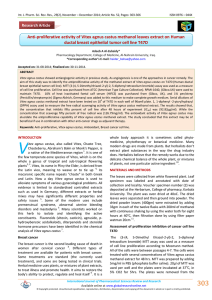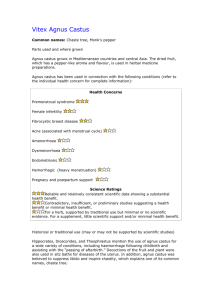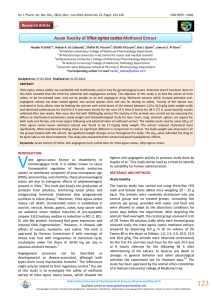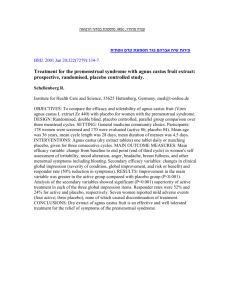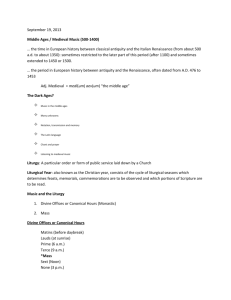Document 13310754
advertisement
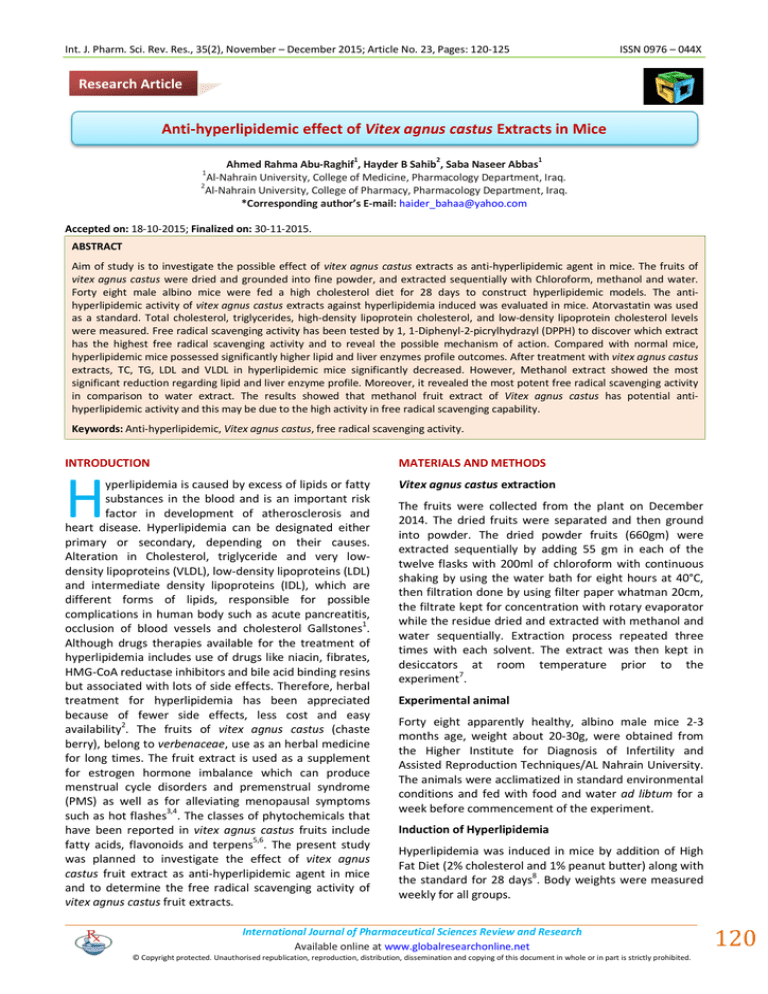
Int. J. Pharm. Sci. Rev. Res., 35(2), November – December 2015; Article No. 23, Pages: 120-125 ISSN 0976 – 044X Research Article Anti-hyperlipidemic effect of Vitex agnus castus Extracts in Mice 1 2 1 Ahmed Rahma Abu-Raghif , Hayder B Sahib , Saba Naseer Abbas Al-Nahrain University, College of Medicine, Pharmacology Department, Iraq. 2 Al-Nahrain University, College of Pharmacy, Pharmacology Department, Iraq. *Corresponding author’s E-mail: haider_bahaa@yahoo.com 1 Accepted on: 18-10-2015; Finalized on: 30-11-2015. ABSTRACT Aim of study is to investigate the possible effect of vitex agnus castus extracts as anti-hyperlipidemic agent in mice. The fruits of vitex agnus castus were dried and grounded into fine powder, and extracted sequentially with Chloroform, methanol and water. Forty eight male albino mice were fed a high cholesterol diet for 28 days to construct hyperlipidemic models. The antihyperlipidemic activity of vitex agnus castus extracts against hyperlipidemia induced was evaluated in mice. Atorvastatin was used as a standard. Total cholesterol, triglycerides, high-density lipoprotein cholesterol, and low-density lipoprotein cholesterol levels were measured. Free radical scavenging activity has been tested by 1, 1-Diphenyl-2-picrylhydrazyl (DPPH) to discover which extract has the highest free radical scavenging activity and to reveal the possible mechanism of action. Compared with normal mice, hyperlipidemic mice possessed significantly higher lipid and liver enzymes profile outcomes. After treatment with vitex agnus castus extracts, TC, TG, LDL and VLDL in hyperlipidemic mice significantly decreased. However, Methanol extract showed the most significant reduction regarding lipid and liver enzyme profile. Moreover, it revealed the most potent free radical scavenging activity in comparison to water extract. The results showed that methanol fruit extract of Vitex agnus castus has potential antihyperlipidemic activity and this may be due to the high activity in free radical scavenging capability. Keywords: Anti-hyperlipidemic, Vitex agnus castus, free radical scavenging activity. INTRODUCTION H MATERIALS AND METHODS yperlipidemia is caused by excess of lipids or fatty substances in the blood and is an important risk factor in development of atherosclerosis and heart disease. Hyperlipidemia can be designated either primary or secondary, depending on their causes. Alteration in Cholesterol, triglyceride and very lowdensity lipoproteins (VLDL), low-density lipoproteins (LDL) and intermediate density lipoproteins (IDL), which are different forms of lipids, responsible for possible complications in human body such as acute pancreatitis, occlusion of blood vessels and cholesterol Gallstones1. Although drugs therapies available for the treatment of hyperlipidemia includes use of drugs like niacin, fibrates, HMG-CoA reductase inhibitors and bile acid binding resins but associated with lots of side effects. Therefore, herbal treatment for hyperlipidemia has been appreciated because of fewer side effects, less cost and easy 2 availability . The fruits of vitex agnus castus (chaste berry), belong to verbenaceae, use as an herbal medicine for long times. The fruit extract is used as a supplement for estrogen hormone imbalance which can produce menstrual cycle disorders and premenstrual syndrome (PMS) as well as for alleviating menopausal symptoms such as hot flashes3,4. The classes of phytochemicals that have been reported in vitex agnus castus fruits include fatty acids, flavonoids and terpens5,6. The present study was planned to investigate the effect of vitex agnus castus fruit extract as anti-hyperlipidemic agent in mice and to determine the free radical scavenging activity of vitex agnus castus fruit extracts. Vitex agnus castus extraction The fruits were collected from the plant on December 2014. The dried fruits were separated and then ground into powder. The dried powder fruits (660gm) were extracted sequentially by adding 55 gm in each of the twelve flasks with 200ml of chloroform with continuous shaking by using the water bath for eight hours at 40°C, then filtration done by using filter paper whatman 20cm, the filtrate kept for concentration with rotary evaporator while the residue dried and extracted with methanol and water sequentially. Extraction process repeated three times with each solvent. The extract was then kept in desiccators at room temperature prior to the experiment7. Experimental animal Forty eight apparently healthy, albino male mice 2-3 months age, weight about 20-30g, were obtained from the Higher Institute for Diagnosis of Infertility and Assisted Reproduction Techniques/AL Nahrain University. The animals were acclimatized in standard environmental conditions and fed with food and water ad libtum for a week before commencement of the experiment. Induction of Hyperlipidemia Hyperlipidemia was induced in mice by addition of High Fat Diet (2% cholesterol and 1% peanut butter) along with the standard for 28 days8. Body weights were measured weekly for all groups. International Journal of Pharmaceutical Sciences Review and Research Available online at www.globalresearchonline.net © Copyright protected. Unauthorised republication, reproduction, distribution, dissemination and copying of this document in whole or in part is strictly prohibited. 120 © Copyright pro Int. J. Pharm. Sci. Rev. Res., 35(2), November – December 2015; Article No. 23, Pages: 120-125 Table 1: Standard and high fat diets composition Standard diet High Fat Diet Seeds (sunflower, groundnut) Seeds (sunflower, groundnut) Cereals Cereals Fruits (grapes, apple) Fruits (grapes, apple) Vegetables Vegetables Vitamin A Vitamin A Vitamin D3 Vitamin D3 Vitamin E Vitamin E Cholesterol powder Peanut butter Experimental design The mice were divided into 6 groups, 8 mice each group: Group 1 (normal): standard diet for 28 days. Group 2 (induced): High Fat Diet (HFD) for 28 days. Group 3 (treated): HFD for 28 days then atorvastatin 10 mg/kg for further 28 days. Group 4: HFD for 28 days then Chloroform extract of vitex agnus castus (VAC) at dose of 500 mg/kg for further 28 days. Group 5: HFD for 28 days then Methanol extract of VAC at dose of 500 mg/kg for further 28 days. Group 6: HFD for 28 days then Water extract of VAC at dose of 500 mg/kg for further 28 days. Animals were treated by oral gavage once a day for a period of 28 days. Blood collection The animals were fasted for 12 hours prior blood collection. Blood was collected by piercing the facial vein with a lancet. The blood samples were collected in plain glass tubes and allowed to clot for 20 minute at room temperature and centrifuged at 3000 RPM for 20 minute. The serum obtained was kept at 0°C until analyzed. Serum was used for the estimation of the serum lipid profile and liver function test. Biochemical analysis Serum lipid total cholesterol (TC), triglyceride (TG), low density lipoprotein (LDL), very low density lipoprotein (vLDL) , high density lipoprotein (HDL), aspartate aminotransferase (AST), B) Alanine aminotransferase (ALT), Alkaline phosphatase (ALP) levels of mice were detected with a biochemical auto-analyzer (Shimadzu, Japan) and respective commercial test kits (Abbott diagnostic, USA) according to the manual instructions. Measurement of oxidative stress The liver was homogenized for malondialdehyde (MDA) investigation. The liver was rinsed in ice-cold PBS (0.02mol/L, pH 7.2-7.4). Remove excess blood thoroughly and weighed before homogenization. The tissues were ISSN 0976 – 044X sliced into small pieces and homogenized them in a certain amount of Phosphate-buffered saline (PBS) (Usually 10mg tissue to 100µl PBS) with a glass homogenizer on ice. The resulting suspension was subjected to two freeze-thaw cycles to further break the cell membranes. After that, centrifugate homogenates for 15 minutes 5000 rpm. 1, 1-diphenyl -2-picrylhydrazyl (DPPH) scavenging activity The free radical scavenging activity of the active extract was measured by using the DPPH method. 200 µl of 0.1 mM DPPH dissolved in methanol was added to 100 µl of the active extract in the following concentrations (500, 250, 125, 62.5, 31.25, 15.625 and 7.813 µg) and incubated for 30 min. This procedure was executed using 96 well plate and each concentration was tested in triplicate, then the absorbance was measured at 517 nm using an ELISA reader. Ascorbic acid (Vitamin C) was used as a positive control. Percentage reduction of DPPH was calculated according to the formula below [8]: %= − ( sample-Abs blank)×100 Statistical analysis Statistical analysis was performed using SPSS (Statistical Package for social Science) version (17), and Microsoft Excel Worksheet 2010. Crude data was analyzed to obtain mean and standard deviation (SD). Student t- test was used to compare between two groups. ANOVA test was used to compare between different groups. P-value of ≤ 0.05 considered being significant and P-value of ≤ 0.001 considered as highly significant. RESULTS Serum lipid profile From the data presented in table 2 it is observed that the administration of high fat diet induced hyperlipidemia in mice (Group 2). Concurrent administration of vitex agnus castus at 500mg/kg body weight (Group IV, Group V and Group VI) respectively showed a significant reduction in the levels of serum total cholesterol, LDL, VLDL as well as triglycerides. In vitex agnus castus extracts groups showed profound reduction in lipid profile; however, the methanol extract had the best results among other extracts. In comparison with atorvastatin treated group, group treated with methanolic fruit extract of vitex agnus castus showed significant increase in serum TG and statistical significant increase in serum TC, LDL and VLDL. Liver enzymes activity In this study, serum alanine aminotransferase (ALT) and aspartate aminotransferase (AST) and alkaline phosphatase (ALP) activities were significantly high in high-cholesterol fed diet than in normal mice. On the other hands, the methanol extract revealed a significant International Journal of Pharmaceutical Sciences Review and Research Available online at www.globalresearchonline.net © Copyright protected. Unauthorised republication, reproduction, distribution, dissemination and copying of this document in whole or in part is strictly prohibited. 121 © Copyright pro Int. J. Pharm. Sci. Rev. Res., 35(2), November – December 2015; Article No. 23, Pages: 120-125 reduction in AST level; while the rest of extracts showed insignificant reduction in liver enzymes activity. In comparison with atorvastatin treated group, group treated with methanolic fruit extract of vitex agnus castus showed significant increase in serum AST and ALT; table 3. Antioxidant activities The MDA were significantly increased in induced (nontreated) group in comparison with healthy group. Meanwhile, the vitex agnus castus fruit extracts had significant reduction in MDA level. However, the ISSN 0976 – 044X glutathione level in all study groups was statistically insignificant; table 2 &3. DPPH assay Figure 1 and 2 showed the dose response curve of methanol and water extract on DPPH scavenging activity. The data is represented as mean ± SDV. The IC50 of DPPH scavenging activity for ME 80.28µg/ml. water extract scavenging activity was 49954.55 µg/ml. ascorbic acid used (positive control) and it showed scavenging activity through the equation Y= 3.7302ln(x) + 75.075 was 0.00120 µg/ml. Table 2: Comparison between hyperlipidemic induced (non-treated) group and induced (hyperlipidemic) group vitex agnus castus fruit extracts in relation to different parameters. Group Induced Healthy Chloroform Body weight (g) 35.383.05 29.99±2.40 a* 30.842.74 Methanol a* 31.062.80 Water a* TC (mg/dl) I 381.13 38.78 117.5020.06 a** 296.1356.98 a** 125.75 14.15 TG (mg/dl) II 346.76 87.91 112.6332.30 a** 275.0052.52 a** 1229.01 HDL (mg/dl) III 40.25 5.92 45.507.07 LDL (mg/dl) IV 271.53 53.10 50.8518.40 69.35 17.58 22.536.46 a** 55.0010.50 a** 207.6327.50 aNS vLDL (mg/dl) V aNS a** 39.885.64 aNS, 190.0059.29 a** AST (U/l) VI 213.88 42.19 20.387.19 ALT (U/l) VII 194.88 66.69 26.6310.32 a** 200.2552.84 aNS ALP (U/I) VIII 226.75 43.35 77.7517.02 a** 220.8831.96 aNS 4.381.36 0.890.16 a** 3.381.37 2.490.52 2.850.45 aNS 2.250.66 MDA (nmol/ml) GSH (µg/ml) X IX aNS 58.65 14.75 a** a** a** 40.506.89 24.41.80 a* 31.13 2.83 a** a** 123.5 16.78 a** 145.6 19.36 a** 40.13 2.23 aNS 54.2 17.36 a** 28.58 4.59 a** a* 197.5 54.30 aNS 178.68 50.37 aNS 186.25 52.4 aNS 212.88 27.33 aNS 219 40.80 aNS 1.53 0.24 a** 2.64 0.20 aNS 174.63 35.69 a* 1.330.2 a** aNS 2.530.45 aNS I II III a: Comparison with induced group, NS: not statistically significant (p>0.05), *: p≤0.05, **: p≤0.001, TC: total cholesterol, TG: triglycerides, HDL: high IV V VI VII density lipoprotein, LDL: low density lipoprotein, vLDL: very low density lipoprotein, AST: aspartate aminotransferase, ALT: alanine VIII IX X aminotransferase, ALP: alkaline phosphatase, MDA: Malondialdehyde, GSH: glutathione. Table 3: Comparison of group treated with methanol fruit extract of vitex agnus castus with induced (non-treated) and Atorvastatin treated group in relation to different parameters Group Body weight (g) TC (mg/dl) I TG (mg/dl) II Induced Atorvastatin Methanol 35.383.05 33.663.36 31.062.80 381.13 38.78 101.0016.86 125.7514.15 a*,bNS a**, b* 346.76 87.91 87.387.58 1229.01 a**, b** HDL (mg/dl) III 40.25 5.92 43.384.72 40.56.89 aNS, bNS LDL (mg/dl) IV 271.53 53.10 34.7816.08 58.6514.75 69.35 17.58 17.142.05 24.401.8 vLDL (mg/dl) V a**, b* a**, b* AST (U/l) VI 213.88 42.19 123.6317.20 174.6335.69 aNS, b** ALT (U/l) VII 194.88 66.69 137.3847.59 178.6350.37 aNS, b** ALP (U/I) VIII 226.75 43.35 213.0046.71 212.8827.33 aNS,bNS 4.381.36 1.15.056 1.330.2 2.490.52 2.550.29 2.530.45 MDA (nmol/ml) GSH (µg/ml) X IX a**, bNS aNS, bNS I a: Comparison with induced group, b: comparison with atorvastatin group, NS: not statistically significant (p>0.05), *: p≤0.05, **: p≤0.001, TC: total II III IV V VI cholesterol, TG: triglycerides, HDL: high density lipoprotein, LDL: low density lipoprotein, vLDL: very low density lipoprotein, AST: aspartate VII VIII IX X aminotransferase, ALT: alanine aminotransferase, ALP: alkaline phosphatase, MDA: Malondialdehyde, GSH: glutathione. International Journal of Pharmaceutical Sciences Review and Research Available online at www.globalresearchonline.net © Copyright protected. Unauthorised republication, reproduction, distribution, dissemination and copying of this document in whole or in part is strictly prohibited. 122 © Copyright pro Int. J. Pharm. Sci. Rev. Res., 35(2), November – December 2015; Article No. 23, Pages: 120-125 Figure 1: The dose response curve of serial dilutions of Vitex agnus castus fruit methanol extract on DPPH free radical scavenging activity. Figure 2: The dose response curve of serial dilutions of Vitex agnus castus fruit water extract on DPPH free radical scavenging activity DISCUSSION Different parts of Vitex agnus castus show different pharmacological activity9.Vitex agnus castus fruits have been show to have a variety of biological activities like in the treatment of menstrual disorders resulting from corpus luteum deficiency, including premenstrual symptoms and spasmodic dysmenorrhea, for certain menopausal conditions and for insufficient lactation10. Cold method or maceration methods where used in this study so as to avoid any loss or destruction to the compounds inside the fruit from exposure to high temperature11,12. In the present study, feeding the mice high fat diet (HFD) for 4 weeks led to highly significant increase in serum total TC, TG, LDL and VLDL in induced (hyperlipidemic) mice as compared to normolipidemic group fed normal standard diet. These changes observed in hyperlipidemic group may be due to that HFD induced hyperlipidemia by demodulating lipid metabolism, mainly by decreasing β-oxidation and increasing cholesterol synthesis and oxidative stress by decreasing free radical 13 scavenger enzyme gene expression . Also, Rui-Li (2006) ISSN 0976 – 044X reported that HFD induced abnormal increases in lipid peroxidation, serum concentrations of total cholesterol, triacylglycerol, and low-density lipoprotein cholesterol in addition to decreased lipoprotein lipase activity, accompanied by a depressed antioxidant defense system14. The serum ALT, AST and ALP levels were extensively elevated in high-cholesterol fed diet than in normal mice. This may due to the disturbance of lipid metabolism because of high fat intake, resulting in accumulation of TG in liver and an increased increment of the liver index, and hepatic steatosis occurred15 since the liver has a crucial role in regulating plasma lipid level all the way through LDL clearance and HDL cholesterol recruitment16. Moreover, the elevation in liver enzymes may also due to excess reactive oxygen species (ROS) production in the mitochondria as a result of lipid overload. The surplus ROS generation exhausted the 17 endogenous antioxidants as reported in . The ROS cause hepatic inflammation by activation cytokines18. Consequently, the excess lipid infiltration, ROS and inflammatory cytokines elicit a condition of liver 19 toxicity . Hence, the liver function markers (AST, ALT and ALP) showed noteworthy leakage in the serum and indicated the membrane damage of the hepatic cells. Malondialdehyde (MDA), which is a product of lipid peroxidation or reaction of oxygen with unsaturated lipids20, was highly significant increased in induced (hyperlipidemic) mice. The elevated levels of MDA in induced (hyperlipidemic) mice suggest increased lipid peroxidation in fat deposits that could be released and have detrimental effects on hepatocytes and other hepatic cells. The serum lipid profile and MDA was found to be declined with extracts of vitex agnus castus in comparison with induced (non-treated) group. However, the range of serum TC, TG, LDL and VLDL of chloroform extract still abnormally high despite the reduction. The effect of methanol extract and atorvastatin on serum TC, TG, LDL and VLDL was comparable although atorvastatin seems to be more effective in certain lipid profile parameters. The reason behind the reduction in lipid profile and liver enzymes activity mostly by methanol extract may due to the diversity of phytochemical compounds of methanol extract such as flavonoids, diterpenoids and iridoids which possess a radical scavenging activity and hepatoprotective properties21. They protect cells from damage induced by oxidative stress which is generally considered to be a cause of degenerative diseases22. Flavonoids may have an additive effect to the endogenous scavenging compounds as they can increase the function of the endogenous 23 antioxidants . In addition, flavonoids and terpenoids may reduce TC, TG, LDL and, VLDL through inhibition of pancreatic lipase which responsible of libration of 24 triglyceride into fatty acids and glycerol . The activity of lipase greatly affects the metabolism of fat and the 25 concentration of triacylglycerols in blood . Glutathione level was not altered in comparison to induced group. Increasing the doses of methanol extract or prolongation International Journal of Pharmaceutical Sciences Review and Research Available online at www.globalresearchonline.net © Copyright protected. Unauthorised republication, reproduction, distribution, dissemination and copying of this document in whole or in part is strictly prohibited. 123 © Copyright pro Int. J. Pharm. Sci. Rev. Res., 35(2), November – December 2015; Article No. 23, Pages: 120-125 of duration of treatment probably will have impact on the level of glutathione. Free radical scavenging activity of vitex agnus castus fruit methanol and water extract was studied and considered important to help understand the mechanism of action of vitex agnus castus extract. It may be due to certain chemical constituents such as polyphenols or terpens which possess good oxygen radical scavenging potential26,27. The results of current study demonstrate that methanol fruit extract of vitex agnus castus had gave the significantly highest antioxidant activity in comparison to the water extract, the methanol extract also showed the highest percentage of antihyperlipidemic activity, as shown by biochemical examination. Its potency in inhibiting lipid profile elevation could be contributed to its significant antioxidant activity, as shown in the DPPH scavenging assay. The results of present study showed positive correlation between hypolipidemic effect and free radical scavenging activity in the vitex agnus castus methanol fruit extract. The total phenolic content of fruits of vitex agnus castus was determined and found as 114.5±2.704 mg Gallic Acid Equivalent (GAE)/g extract28. Plant materials rich in phenolic components exhibit protective role against lipid peroxidation29. REFERENCES ISSN 0976 – 044X hyperlipidemic mice. World Journal of Gastroenterology, 19(20), 2013, p 3150-3156. 9. Eugenio JG, Tatiane Luiza CO, Severino Matias de Alencar, Alessandra Reis, Alessandro D. Loguercio, Rosa Helena Miranda Grande. Antioxidant Activity by DPPH Assay of Potential Solutions to be Applied on Bleached Teeth. Braz Dent J, 23(1), 2012, 22-27. 10. Daniele C1, Thompson Coon J, Pittler MH, Ernst E. Vitex agnus castus: A systematic review of adverse events. Drug Safety, 28(4), 2005, 319-332. 11. Pearlstein, T., & Steiner, M. Premenstrual dysphoric disorder: burden of illness and treatment update. Journal of Psychiatry & Neuroscience, 33(4), 2008, 291–301. 12. Hayder b. Sahib, adeeb a al-zubaidy, shallal m hussain, ghaith ali jassim. the anti angiogenic activity of vitex agnus castus leaves extracts. International Journal of Pharmacy and Pharmaceutical Sciences, Vol 6, Suppl 2, 2014, 863869. 13. Rui-Li Y, Wu Li, Yong-Hui Sh. and Guo-Wei Le. Lipoic acid prevents high-fat diet–induced dyslipidemia and oxidative stress: A microarray analysis. Nutrition, 24(6), 2008, 582. 14. Yan M X, Yan-Qing L, Min M, Hong-Bo R and Yi K. Long-term high-fat diet induces pancreatic injuries via pancreatic microcirculatory disturbances and oxidative stress in rats with hyperlipidemia. Biochem. Biophys. Res. Comm., 347(1), 2006, 192. 15. Yin Y, Yu Z, Xia M, Luo X, Lu X, Ling W. Vitamin D attenuates high fat diet induced hepatic steatosis in rats by modulating lipid metabolism. Eur J Clin Invest, 42, 2012, 1189-1196. 1. Priyanka Phogat, Aakash Deep, Prabodh Chander Sharma, Sanjeev K. Mittal, Saloni Kakkar, Ruchi Goyal, Kapil Thakral. Introduction to Hyperlipidemia and Its Management: A Review. Pharmacologyonline, 2, 2010, 251-266. 2. Dhaliya Salam. A, Surya A. S, Dawn V Tomy, Dr. Betty Carla, Dr. Arun Kumar, Dr. C. Sunil. A review of hyperlipidemia and medicinal plants. Int.J.A.PS.BMS, 2(4), 2013, 219-237. 16. Naveed Sattar and David Preiss. Non-alcoholic fatty liver disease: an overview of prevalence, diagnosis, pathogenesis and treatment considerations. Clin Sci (Lond), 115(5), 2008, 141-50. 3. Berger D, Schaffner W, Schrader E, Meier B, Brattstrom A. Efficacy of Vitex agnus castus L. extract Ze 440 in patients with pre-menstrual syndrome (PMS). Archieve of Gynecology & Obstetric, 264(3), 2000, 150-153. 17. Pessayre D., Mansouri A. & Fromenty B. Mitochondrial dysfunction in steatohepatitis. American Journal of Physiology Gastrointestinal and Liver Physiology, 282, 2002, G193–G199. 4. Schellenberg R. Treatment for the premenstrual syndrome with agnus castus fruit extract: prospective, randomised, placebo controlled study. BMJ, 322(7279), 2001, 134-137. 5. Hajdú Z, Hohmann J, Forgo P, Martinek T, Dervarics M, Zupkó I, Falkay G, Cossuta D, Máthé I., “Diterpenoids and flavonoids from the fruits of Vitex agnus-castus and antioxidant activity of the fruit extracts and their constituents,”. Phytotherapy Research, vol. 21, no. 4, 2007, pp. 391–394. 18. Weisberg P S, Leibel R & Tortoriello V D. Dietary curcumin significantly improves obesity-associated inflammation and diabetes in mouse models of diabesity, Endocrinology, 149(7), 2008, 3549-58. 6. Esra Maltaş, Ahmet Uysal, Salih Yıldız and Yusuf Durak. Evaluation of antioxidant and antimicrobial activity of vitex agnus castus l. Fresenius Environmental Bulletin. volume 19 – No 12b, 2010, 3049-3099. 7. Hayder B. Sahib*, Adeeb A Al-Zubaidy, Shallal M Hussain, Ghaith Ali Jassim Ban J Qasim4, sawsan S. Al Rawi Acute toxicity of Vitex agnus castus methanol extracts International Journal of Pharmacy research and review. 26(2), 2014, 123-128. 8. Li-Xin Wang, Kai Liu, Da-Wei Gao, Ji-Kui Hao. Protective effects of two Lactobacillus plantarum strains in 19. Demori I, Voci A, Fugassa E & Burlando B. Combined effects of high-fat and ethanol induce oxidative stress in rat liver. Alcohol, vol 40, issue 3, 2006, p 185-191. 20. Antonio Ayala, Mario F. Muñoz, and Sandro Argüelles. Lipid Peroxidation: Production, Metabolism, and Signaling Mechanisms of Malondialdehyde and 4-Hydroxy-2Nonenal. Hindawi Publishing Corporation, Volume 2014, Article ID 360438, 2014, 31 pages. 21. Kim JH, Lee BC, Kim JH, Sim GS, Lee DH, Lee KE, Yun YP, Pyo HB. The isolation and antioxidative effects of vitexin from Acer palmatum. Achieve of Pharmacal Research, 28, 2005, 195-202. 22. Kim IS, Yang MR, Lee OH, Kang SN. Antioxidant Activities of Hot Water Extracts from Various Spices. International Journal of Molecular Sciences, 12, 2011, 4120-4131. International Journal of Pharmaceutical Sciences Review and Research Available online at www.globalresearchonline.net © Copyright protected. Unauthorised republication, reproduction, distribution, dissemination and copying of this document in whole or in part is strictly prohibited. 124 © Copyright pro Int. J. Pharm. Sci. Rev. Res., 35(2), November – December 2015; Article No. 23, Pages: 120-125 23. Robert J Nijveldt, Els van Nood, Danny EC van Hoorn, Petra G Boelens, Klaske van Norren, and Paul AM van Leeuwen. Flavonoids: a review of probable mechanisms of action and potential applications. American Society for Clinical Nutrition. 74, 2001, 418–25. 24. Morikawa T, Xie Y, Asao Y, Okamoto M, Yamashita C, Muraoka O, Matsuda H, Pongpiriyadacha Y, Yuan D, Yoshikawa M. Oleanane-type triterpene oligoglycosides with pancreatic lipase inhibitory activity from the pericarps of Sapindus rarak. Phytochemistry, 70, 2009, 1166–1172. 25. Nakai M, Fukui Y, Asami S, Toyoda-Ono Y, Iwashita T, Shibata H, Mitsunaga T, Hashimoto F, Kiso Y. Inhibitory Effects of Oolong Tea Polyphenols on Pancreatic Lipase in Vitro. Journal of Agricultural and Food Chemistry, 53, 2005, 4593–4598. ISSN 0976 – 044X 26. Mu H, Porsgaard T. The metabolism of structured triacylglycerols. Progress in Lipid Research, 44, 2005, 430448. 27. Williams R. J., Spencer J. P., & Rice-Evans C. Flavonoids: Antioxidants or signalling molecules? Free Radical Biology and Medicine, 36(7), 2004, 838–849. 28. Schewe T., Steffen Y., Sies H. How do dietary flavanols improve vascular function? A position paper. Arch Biochem Biophys, 476, 2008, 102–106. 29. Gökbulut A, Özhan O, Karacaoğlu M, Şarer E. Radical Scavenging Activity and Vitexin Content of Vitex agnuscastus Leaves and Fruits. Fabad Journal of Pharmaceutical Sciences, 35, 2010, 85–91. Source of Support: Nil, Conflict of Interest: None. International Journal of Pharmaceutical Sciences Review and Research Available online at www.globalresearchonline.net © Copyright protected. Unauthorised republication, reproduction, distribution, dissemination and copying of this document in whole or in part is strictly prohibited. 125 © Copyright pro
